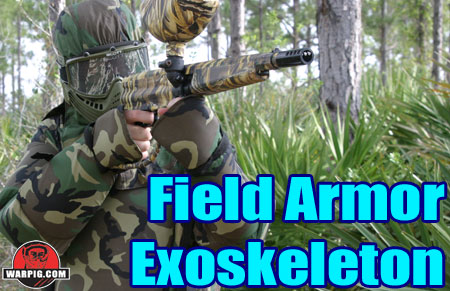  |
|
|
|
|
|
|
  |
|
|
|
|
|
|

What
do you think?
|

Field Armor Exoskeleton By Bill Mills - May 2004 For some people the moment they hear about paintball they can’t wait to play. For others there’s no way they are going to ever try “that crazy war game.” There is a third group of people though, those who think the idea of the game is fun and exciting, but are afraid of getting hurt by a paintball hit. For that group of potential players, the Field Armor Exoskeleton may be the ticket to get into the game. Players who have been active on the
Internet since the early 1990s, may remember the discussions of mouse-pad
armor from the rec.sport.paintball newsgroup. Field Armor takes that
concept to a level of professional construction in their exoskeleton.
Sewn into the suit covering is a dense cell foam, similar in weight and flexibility to the neoprene used in wetsuits. The foam armor sections protect the fronts of the shins, the knees, the fronts and backs of the thighs, the buttocks, the groin, the back, the outer upper and lower arms, the elbows, the backs of the hands, the chest, the neck and throat. An additional hood, reminiscent of JT’s “Anti Ambush Hood” from the late 80s lacks padding, but does provide additional head protection, as well as tying in the color or camo pattern of the suit to the head.
A row of three pockets on the right hip are sized to hold 100 round paintball pods. One hundred and forty round pods will also fit on the right hip, when the elastic retainer straps are stretched to near their limit. Up between the rib cage and left arm are strips the can hold two more 100 or 140 round tubes. A pocket on the right side of the rib cage is large enough for a small paint grenade, and hip pockets are zippered for car keys and the like. A short narrow pocket on the left thigh is complimented by a loop just below the hip to secure a squeegee in easy reach.
The exoskeleton reviewed for this article was a large Stalker model in woodland camo. Surprisingly once on, the suit was not at all restrictive, providing easy movement. It was noted that the groin area is not completely padded, and the additional protection of a sports cup is a good idea. The gaps between most of the padded areas are approximately one inch, and in places necessary to maintain flexibility for the wearer. Informal testing of the suit involved the test volunteer being shot at with a barrage of approximately 30 DraXxus Hellfire paintballs from distance of 50 feet with a 2003 Shocker which had been adjusted to 295 feet per second. Despite the comfort of the suit there was still a tendency to duck and swerve to avoid being hit by the paint. A hit to the inside of the elbow and another to the lower front of the thigh stung and bruised, as did another on the shoulder. It was only after the test firing that the subject learned that most of the thirty shots had hit him, the only ones that he even felt had struck the seams between pads in the suit, and a third that bounced off the top of the back pad and up under the earpiece of his Profiler mask.
In the heat of a Florida mid day sun, the ability to fold over the chest pad allowing air through the suit’s vents was a welcome relief when stepping off of the field. Upon inspection of the suit after firing, it was determined that no paintballs had broken on any of the suit’s padded sections. While the existence of the padding would prohibit the use of the exoskeleton under most major tournament series rules, fields allowing their use for recreational play may wish to count bounced paintballs as well as broken paintballs for eliminations, much as scenario game rules do with ghillie suits. The Field Armor Exoskeleton represents
a surprising level of protection against bruises and welts for paintball
players. In addition having a market amongst paintball players, the
exoskeletons also pose an opportunity as rental equipment for paintball
fields looking to offer a way to introduce new players to the game of paintball.
The suit may be used them as a way to overcome their fear of getting hit
by a paintball.
|
| Copyright © 1992-2019
Corinthian Media Services. WARPIG's webmasters can be reached through our feedback form. All articles and images are copyrighted and may not be redistributed without the written permission of their original creators and Corinthian Media Services. The WARPIG paintball page is a collection of information and pointers to sources from around the internet and other locations. As such, Corinthian Media Services makes no claims to the trustworthiness or reliability of said information. The information contained in, and referenced by WARPIG, should not be used as a substitute for safety information from trained professionals in the paintball industry. |